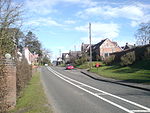Claverdon railway station
AC with 0 elementsFormer Great Western Railway stationsPages with no open date in Infobox stationRailway request stops in Great BritainRailway stations in Great Britain opened in 1860 ... and 6 more
Railway stations in WarwickshireRailway stations served by Chiltern RailwaysRailway stations served by West Midlands TrainsUse British English from February 2018Warwickshire building and structure stubsWest Midlands (region) railway station stubs

Claverdon railway station serves the village of Claverdon in Warwickshire, England. It is managed by West Midlands Railway, although most of the services from the station are operated by Chiltern Railways. It is a request stop for West Midlands Railway services that call at the station, but a regular stop for Chiltern Railways services. The line on which the station stands was opened by the Stratford on Avon Railway as a single-track branch in 1860, but was doubled between Bearley and Hatton in 1938 and a new two-platform station was built at Claverdon. When the second track was lifted in 1969 Claverdon reverted to being a single-platform station.
Excerpt from the Wikipedia article Claverdon railway station (License: CC BY-SA 3.0, Authors, Images).Claverdon railway station
Station Road, Stratford-on-Avon Claverdon CP
Geographical coordinates (GPS) Address External links Nearby Places Show on map
Geographical coordinates (GPS)
| Latitude | Longitude |
|---|---|
| N 52.2771 ° | E -1.6965 ° |
Address
Claverdon
Station Road
CV35 8PE Stratford-on-Avon, Claverdon CP
England, United Kingdom
Open on Google Maps








